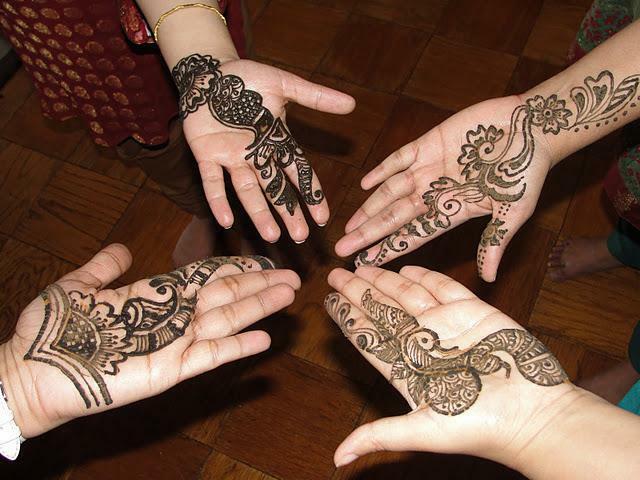Design Of Henna Mehndi Biography
Source(google.com.pk)If you are interested in knowing the details of Mehendi, consider reading the following text. It is taken from Wikipedia under Creative Commons Attribution Share Alike License.
Mehendi Info:
Mehndi is the application of henna as a temporary form of skin decoration in Pakistan and India, as well as by expatriate communities from these areas. Mehndi decorations became fashionable in the West in the late 1990s, where they are sometimes called henna tattoos. Henna is typically applied during special occasions like weddings and festivals. It is usually drawn on the palms and feet, where the color will be darkest because the skin contains higher levels of keratin which binds temporarily to lawsone, the colorant of henna. Henna was originally used as a form of decoration mainly for brides.
The term henna tattoo is inaccurate, because tattoos are defined as permanent surgical insertion of pigments underneath the skin, as opposed to pigments resting on the surface as is the case with mehndi.
Likely due to the desire for a “tattoo-black” appearance, many people have started adding the synthetic dye p-Phenylenediamine (PPD) to henna to give it a black colour. PPD is extremely harmful to the skin and can cause severe allergic reactions resulting in permanent injury or death.Alata (Mahur) is a flower-based dye used to paint the feet of the brides in some regions of India. It is still used in Bengal.
East countries adopting many cultures from western except mehendi. In western culture there is lot of use tattoos but in India, Pakistan, Bangladesh and many countries in Asia are using Mehendi in all respective occasions. In South India Hyderabad and Bidar has lot of commercial shops of mehendi. Like Pakeezah, Golden, Dulhan, Zoom Golden, Karachi etc.
Henna paste is usually applied on the skin using a plastic cone or a paint brush, but sometimes a small metal-tipped jacquard bottle used for silk painting (a jac bottle) is employed. The painted area is then wrapped with tissue, plastic, or medical tape to lock in body heat, creating a more intense colour on the skin. The wrap is worn three to six hours, or sometimes overnight and then removed. When first removed, the henna design is pale to dark orange in colour and gradually darkens through oxidation, over the course of 24 to 72 hours. The final colour is reddish brown and can last anywhere from one to three weeks depending on the quality and type of henna paste applied, as well as where it was applied on the body (thicker skin stains darker and longer than thin skin).
[edit] Mehndi celebration
Weddings in India, Pakistan and Bangladesh are considered to be a sacred and sanctified ceremony. They can often be long ritualistic and elaborate affairs with lots of pre-wedding, wedding and post wedding ceremonies. The occasion of Mehndi ceremony is often one of the most important pre-wedding rituals especially for the bride. It is a fun filled ritual, which is celebrated mainly by the bride’s family. Different regions of the country celebrate the ritual in a different way according to their own marriage customs, rituals, and culture. Mehndi ceremonies take place outside the Indian sub-continent amongst the Asian community and places like Birmingham in the UK are such known hotspots for lavish Mehndi celebrations.
The ceremony is mainly held at the bride’s house or at a banquet hall on the eve of the marriage ceremony or few days before the marriage. Generally the bride and groom attend the event together and on the occasion a professional henna artist or a relative applies mehndi to the bride’s hands and feet the designs are very intricate. Often hidden within the mehndi pattern the name or initials of the groom are applied. The event generally has a celebratory festival feel to it with the women dancing and singing traditional songs and the girls wearing vivid colours such as hot pink and yellow, often if the bride to be wishes to tease her future groom she will make him wear purple. The groom usually wears jutti instead of western footwear.
Design Of Henna Mehndi New Henna Mehndi Designs Pics Images Wallpapers

Design Of Henna Mehndi New Henna Mehndi Designs Pics Images Wallpapers

Design Of Henna Mehndi New Henna Mehndi Designs Pics Images Wallpapers

Design Of Henna Mehndi New Henna Mehndi Designs Pics Images Wallpapers

Design Of Henna Mehndi New Henna Mehndi Designs Pics Images Wallpapers
Design Of Henna Mehndi New Henna Mehndi Designs Pics Images Wallpapers

Design Of Henna Mehndi New Henna Mehndi Designs Pics Images Wallpapers

Design Of Henna Mehndi New Henna Mehndi Designs Pics Images Wallpapers

Design Of Henna Mehndi New Henna Mehndi Designs Pics Images Wallpapers
Design Of Henna Mehndi New Henna Mehndi Designs Pics Images Wallpapers

Design Of Henna Mehndi New Henna Mehndi Designs Pics Images Wallpapers

Design Of Henna Mehndi New Henna Mehndi Designs Pics Images Wallpapers

Design Of Henna Mehndi New Henna Mehndi Designs Pics Images Wallpapers

Design Of Henna Mehndi New Henna Mehndi Designs Pics Images Wallpapers
Design Of Henna Mehndi New Henna Mehndi Designs Pics Images Wallpapers
No comments:
Post a Comment